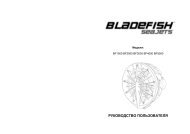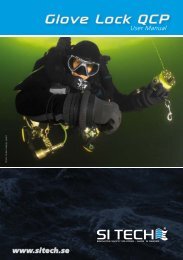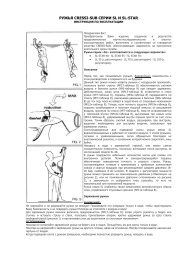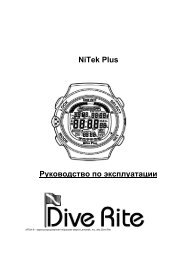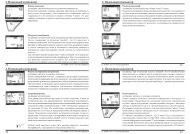Galileo SOL Manual - Scubapro
Galileo SOL Manual - Scubapro
Galileo SOL Manual - Scubapro
You also want an ePaper? Increase the reach of your titles
YUMPU automatically turns print PDFs into web optimized ePapers that Google loves.
3. Diving with <strong>Galileo</strong><br />
The fi fth page shows the MB level with<br />
which the dive was started and, if there<br />
was an MB level reduction, what the fi nal<br />
MB level was. It also shows the average<br />
heart rate (if available), the altitude class,<br />
the lowest battery level during the dive and<br />
the amount of gas consumed.<br />
The sixth page shows a listing of all the<br />
alarms and warnings that were triggered<br />
during the dive.<br />
Within the list of dives there is also Dive<br />
statistics with a range of dates. On this<br />
page you can see the longest dive ever made<br />
with the computer, the deepest dive, the total<br />
time spent underwater, the total number of<br />
dives and also the number of hours that the<br />
computer has been on (on the surface or<br />
diving) since the last battery change.<br />
At any point in time inside the Logbook<br />
menu, press EXIT to return to the main<br />
Logbook menu.<br />
3. DIVING WITH GALILEO<br />
3.1 Nitrox<br />
Nitrox is the term used to describe breathing<br />
gases made of oxygen-nitrogen mixes with<br />
oxygen percentage higher than 21% (air).<br />
Because Nitrox contains less nitrogen<br />
than air, there is less nitrogen loading on<br />
the diver’s body at the same depth as<br />
compared to breathing air.<br />
However, the increase in oxygen concentration<br />
in Nitrox implies an increase in oxygen partial<br />
pressure in the breathing mix at the same<br />
depth. At higher than atmospheric partial<br />
pressures, oxygen can have toxic effects on<br />
the human body. These can be lumped into<br />
two categories:<br />
- Sudden effects due to oxygen partial<br />
pressure over 1.4bar. These are not<br />
related to the length of the exposure to<br />
high partial pressure oxygen, and can<br />
vary in terms of the exact level of partial<br />
pressure they happen at. It is commonly<br />
accepted that partial pressures up to<br />
1.4bar are tolerable, and several training<br />
agencies advocate maximum oxygen<br />
partial pressures up to 1.6bar.<br />
- Long exposure effects to oxygen partial<br />
pressures over 0.5bar due to repeated<br />
and/or long dives. These can affect the<br />
central nervous system, cause damage<br />
to lungs or to other vital organs.<br />
<strong>Galileo</strong> keeps you safe with respect to these<br />
two effects in the following ways:<br />
1) Against sudden effects: <strong>Galileo</strong> has<br />
an MOD alarm set for a user-defi ned<br />
ppO 2max. As you enter the oxygen<br />
concentration for the dive, <strong>Galileo</strong><br />
shows you the corresponding MOD<br />
for the defi ned ppO 2max. The default<br />
value of ppO 2max from the factory is<br />
1.4bar. This can be adjusted to your<br />
preference between 1.2 and 1.6bar. It<br />
can also be turned OFF. Please refer to<br />
section 2.3.4 for more information on<br />
how to change this setting.<br />
2) Against long exposure effects: <strong>Galileo</strong><br />
“tracks” the exposure by means of the<br />
CNS O 2 clock. At levels of 100% and<br />
42






